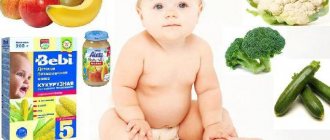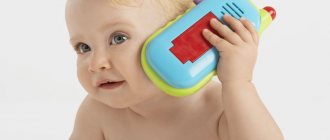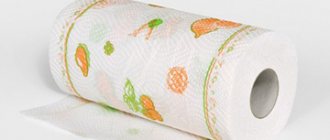The main and healthiest food for a baby under one year old is breast milk. The transition from maternal, artificial or mixed feeding to the adult table is carried out through the period of introduction of complementary foods, when the child gets acquainted with new food, learns to eat and drink with the help of utensils.
The optimal order and timing of introducing products, described in detail by experts, is the key to the health of the digestive system. But mothers always have many questions, including when can they give their child juice and, if they have a runny nose, can they drip Kalanchoe juice into their nose, for example.
When and how to introduce complementary foods
It is rational to begin introducing complementary foods in the interval from 4 to 6 months. During this period, immunological tolerance to food is observed - minimal risk of adverse reactions. Up to 12 months, dairy-free cereals, vegetables, meat, fermented milk products, fruit purees and fish are introduced into the diet.
Fruit purees are distinguished by the presence of plant fiber, which smoothes out the negative effects of fruit acids, adds volume to the food eaten and counteracts constipation.
In fact, there is no need to introduce fruit juices into the diet of children under one year of age, but if parents wish, from the age of eight months onwards, infants can be given juices after mastering the appropriate vegetable and fruit purees (beet juice - when digesting beets , apple juice - apples, etc.).
According to WHO, they are foods with low energy value and high sugar content. Their introduction causes a refusal of higher-calorie foods and addiction to the sweet taste of foods, which can lead to caries in early childhood.
Practical tips for drinking juice:
- Do not let your baby drink juice from a bottle. The child drinks from the bottle slowly, which means the sugar may linger on his teeth. It's better to use a sippy cup.
- Dilute the juice with water. This will reduce the amount of sugar and help quench your thirst.
- Juice is a treat that should be given after a meal. Before eating, it may reduce your appetite.
- Packaged baby juice should not contain sugar or fructose.
- Fruit puree is healthier than juice. You can mix it with water and give it to your child as a tasty smoothie. Monitor your baby's drinking regime. Juice cannot replace water!
(46 ratings; article rating 4.5)
Share Share Share
Basic rules for introducing new foods into the diet
Introducing new foods into your baby’s diet requires following some rules:
- Only for a healthy baby.
- The time when you can give your child juice for the first time is in the morning.
- Complementary foods are offered to the baby before breast milk, and drinks are offered after the main meal.
- Complementary feeding is given to the child in a sitting position using appropriate utensils: plates, spoons and cups or sippy cups.
- The new product is introduced gradually. On the first day, give a few drops of juice. If no adverse reactions occur, the next day - twice as much and so on until reaching 100 ml per day.
- The baby is given freshly squeezed juices, diluted twice with drinking (but not distilled!) water. It is not advisable to give industrially produced drinks before the age of three. The indication on the packaging of permission for use from the first months of life is a marketing ploy, and not a recommendation from pediatricians.
What juices to give to an infant
At home, juices are prepared using a juicer or manually. The latter method involves chopping the fruit on a grater and then squeezing it through cheesecloth (this procedure is similar to carrot juice for babies). High hygienic requirements are imposed on any cooking method: dishes are regularly washed and rinsed with boiling water.
The first is apple juice for babies, the second is pear juice, then it’s turn to carrot juice for children. Gradually, the diet expands: children are given pumpkin, squash, apricot, plum, and beet juice.
Children under 3 years of age should not be given drinks made from exotic fruits, including citrus fruits. Berry fruits can be offered to children over two years of age after a trial introduction of 2-3 berries into the diet.
You should not equate fruit juice with fruit drink - jam diluted with drinking water. The latter contains mainly water and sugar, but absolutely no vitamins.
You should also be wary of fruit juices for children, to which sweeteners such as mannitol and sorbitol are added during production. They have a laxative effect.
Contrary to the opinion of the older generation
Young parents are often pressured by the older generation. Dozens of pieces of advice are thrown at moms and dads every day, along with the weighty argument: “We raised three people.” One of the popular recommendations from grandmothers is apple juice for children a little older than a month of age. Indeed, this is what Soviet pediatricians recommended in the second half of the last century. Since then, studies have been conducted proving not only the lack of benefit, but also the danger of early introduction of juice into the diet of children.
The fact is that Soviet babies, already at three months old, were sent to nurseries, where they were fed artificially, far from the modern understanding of adapted formulas. The early introduction of apple juice was justified by the child’s need for vitamins and microelements, especially iron. Today, the approach to feeding children has undergone significant changes. Young parents will have to argue reasonably with their grandmothers about the age at which they can give their child juices, citing the following facts:
- Breast milk is the best nutrition for a baby. Artificial formulas are prescribed only for certain diseases of the baby or mother or for quantitative lack of breast milk as supplementary feeding.
- A child in the first six months of life successfully receives all the necessary vitamins and microelements from breast milk. Modern adapted mixtures, including economy class, are additionally enriched with vitamins and iron.
- Iron from plant foods is practically not absorbed by the baby's body, unlike iron from breast milk.
- Fruit acids are very aggressive for the digestive system of a baby in the first half of life.
- When introducing any foods into complementary foods before children reach 4 months of age, there is a high risk of an allergic reaction.
Let's look at how many months you can give fruit juices to children.
Store-bought fruit juices for children are not only not healthy, but also harmful.
Even 15 years ago, WHO recommended for the prevention of cardiovascular diseases, diabetes and obesity daily consumption of 5 servings of vegetables and fruits, where a serving is the amount of food in a handful - 1 apple, 2 tomatoes, or a handful of lettuce, or a glass of juice.
But today, fruit juices cannot be considered a healthy and necessary drink, especially for children. Active promotion of the benefits of fruit juices is nothing more than a marketing technique. The BBC, for example, proposes excluding juices from the list of healthy foods that are recommended for daily consumption:
- The main argument is the presence of 6 teaspoons of sugar per glass of water in reconstituted juices, which is even more than in Coca-Cola. This is fraught with the development of diabetes, obesity, caries, etc. Therefore, juice can be given to a child only occasionally, as an alternative to candy or other sweets. Moreover, you should not give juices to quench your thirst, since the effect will be exactly the opposite.
- The indication “sugar-free” on the label should also be alarming, since such a marketing ploy to increase sales indicates the presence of artificial sweeteners and sugar substitutes, the harm of which is also obvious (E950 Acesulfame potassium, E951 aspartame).
- Also, citric acid is often added to juices, which impedes the absorption of calcium and contributes to the destruction of tooth enamel.
- Juices can cause an allergic reaction, diarrhea, and provoke the development of dysbacteriosis and diseases of the gastrointestinal tract.
- There are large quantities of juice-containing drinks on sale, so-called nectars with a reduced juice content of 15-50%, the rest is sugar syrup and flavorings identical to natural ones, as well as artificial vitamins (see myths about synthetic vitamins).
- British dentists warn that the high acidity of fruit smoothies and juices poses an even greater danger to children's teeth than sweets. First, acids corrode the enamel, then chips and cracks appear in which bacteria that cause caries multiply. Dentists complain that the younger generation of children in the UK refuses to drink plain water, preferring fruit juices.
How can a drink prepared as follows be useful? The vacuum bags that we buy in stores contain “reconstituted juice,” that is, a concentrate diluted with water.
Simply put, it is a sweet liquid with the taste of fruit, which does not contain natural vitamins, but contains artificial ones, the dangers of which for both adults and children have been talked about for a long time.
After the fruit is juiced, the liquid is removed using modern technology, the resulting concentrate is frozen, and when it is time to use it, it is diluted with water and pasteurized to prevent the growth of pathogenic bacteria and increase shelf life. This cannot in any way be called a useful product; a drink that has gone through so many stages of processing does not and cannot have any beneficial properties.
To benefit from the juice, you should wash the fruit, squeeze out the juice, and drink it within 10 minutes after preparing it. Drink in small sips for better absorption and no more than 150 grams per day. Why? In one glass of orange juice, for example, there are 3-4 oranges; naturally, a child cannot eat that much, so it is difficult for him to drink such an amount, and there is no need for it.
It is better to give your baby the fruit itself or a puree of it; it contains fiber that is good for the gastrointestinal tract and natural vitamins. Thus, the child will eat as much as he wants, as much as his body requires. Because children eat only the amount of food they need, unlike adults, whose sense of proportion and such control becomes dulled with age.
Publication date 11/13/2014 Prepared by: Selezneva Valentina Anatolyevna








